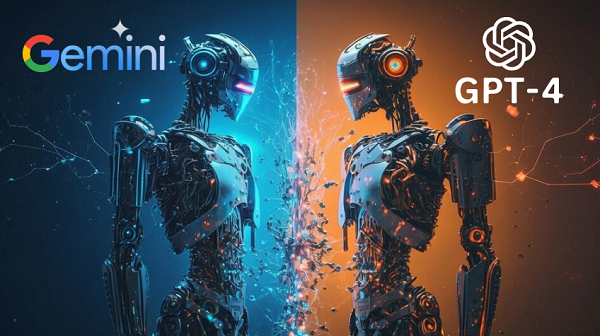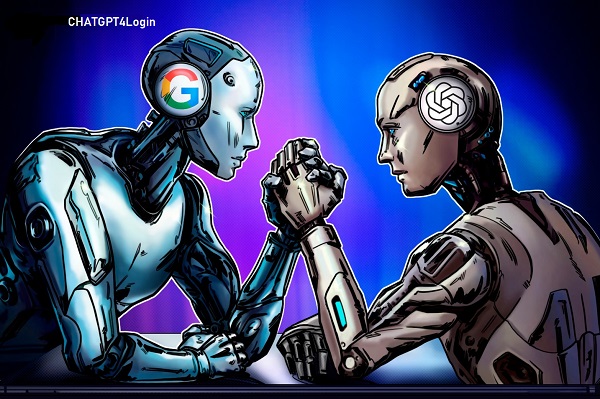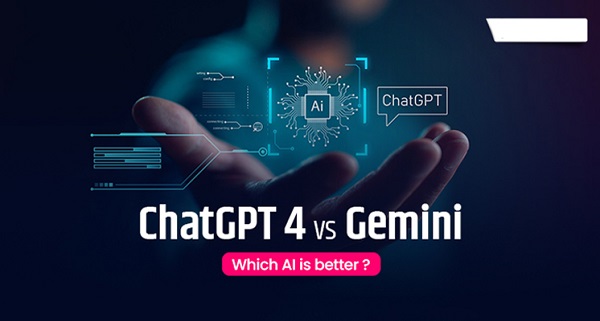Gemini AI vs. ChatGPT 4: A Comparative Analysis
Gemini AI vs. ChatGPT 4: A Comparative Analysis. As artificial intelligence (AI) continues to advance, two of the most prominent systems, Google’s Gemini AI and OpenAI’s ChatGPT-4, are making waves in the AI landscape. Both models represent the cutting edge of conversational and multimodal AI technologies, offering unique strengths and capabilities. This extended analysis will explore their core functionalities, differences, applications, and potential implications for the future.

Core Capabilities
1. Multimodality
Gemini AI: One of Gemini’s defining features is its multimodal capability. It can process and generate outputs in various formats, including text, images, audio, and video. For example, Gemini can analyze images to extract information, summarize videos, and even compose music based on textual input. This makes it ideal for tasks that require integrated data interpretation across multiple formats.
ChatGPT-4: While ChatGPT-4 is primarily text-focused, it can generate creative outputs and code and assist with problem-solving. Through integrations like DALL-E 2, it extends its abilities to create images. However, its multimodal functionalities are limited compared to Gemini’s seamless integration.
Verdict: Gemini’s multimodal nature gives it a significant advantage in tasks requiring interactions across multiple data types. Gemini AI vs. ChatGPT 4: A Comparative Analysis.
2. Reasoning and Problem-Solving
Gemini AI: Excels in logical reasoning, critical thinking, and problem-solving across various domains. Its ability to synthesize information from multiple sources (text, images, etc.) makes it versatile in tackling complex challenges that require a holistic understanding.
ChatGPT-4: Known for its strong language-based reasoning capabilities, ChatGPT-4 handles intricate queries, ethical dilemmas, and problem-solving scenarios effectively. It can engage in nuanced discussions, making it a reliable tool for text-heavy tasks like research and analysis.
Verdict: Both models are strong contenders, but Gemini’s edge in multimodality gives it broader applicability in solving complex, cross-modal problems.
3. Creative Content Generation
ChatGPT-4: Renowned for its creative prowess, ChatGPT-4 excels in generating engaging stories, poems, and scripts. Its language-generation capabilities allow for nuanced and imaginative outputs tailored to diverse audiences and contexts.
Gemini AI: While Gemini shows promise in creative tasks, its primary strength lies in integrating creativity with multimodal data. For instance, it can generate a video concept complete with audio and script, which extends beyond pure text-based creativity.
Verdict: ChatGPT-4 dominates in pure text-based creativity, while Gemini stands out in multimedia creative applications.

4. Code Generation and Debugging
Both Gemini AI and ChatGPT-4 are proficient in code generation and debugging. They can write, analyze, and debug code across various programming languages. However, Gemini’s multimodal features allow it to analyze visual coding aids like flowcharts, which ChatGPT-4 does not inherently support.
Verdict: Both models are highly capable, but Gemini may have a slight advantage for coding tasks involving visual data.
Key Differences
1. Multimodal Capabilities
Gemini AI: Offers seamless integration of multiple modalities, making it a general-purpose AI capable of handling text, images, video, and audio simultaneously.
ChatGPT-4: Primarily excels in text-based tasks, with limited multimodal functionality through external integrations like DALL-E.
Impact: Gemini’s multimodality positions it as a better tool for tasks requiring integration across diverse data types.
2. Focus Areas
Gemini AI: Designed for broad applications, including research, multimedia content creation, and accessibility.
ChatGPT-4: Focuses on text-heavy tasks like content creation, conversational AI, and code-related applications.
Impact: While ChatGPT-4 has carved a niche in textual and conversational domains, Gemini’s broader focus gives it a competitive edge in multidisciplinary applications.
3. Training Data
The distinct training data used for these models contributes to their unique strengths:
- Gemini AI: Likely trained on a highly diverse multimodal dataset, enabling it to handle text, images, audio, and video seamlessly.
- ChatGPT-4: Focused on extensive text and code datasets, making it particularly adept at understanding and generating nuanced language-based outputs.
Applications and Use Cases

Gemini AI
Research and Development:
Analyzes scientific data, such as medical images, and synthesizes findings from multimodal inputs.
Aids in complex research requiring integrated data processing.
Content Creation:
Generates multimedia outputs, such as music compositions, video scripts, and image designs.
Enhances creative projects by combining text with visuals or audio.
Customer Service:
Powers advanced chatbots capable of handling queries involving multiple data types (e.g., product photos, audio messages).
Accessibility:
Creates assistive technologies, like image-to-text converters for visually impaired users.
ChatGPT-4
Content Creation:
Excels in writing articles, creating stories, and translating languages.
Generates creative content tailored to specific audiences and contexts.
Software Development:
Assists developers with code generation, debugging, and documentation.
Research and Analysis:
Summarizes large volumes of text, interprets research papers, and generates insights.
Education:
Personalizes learning experiences, provides tutoring, and supports educators in lesson planning.
Also Read: Gemini AI: Exploring Google’s Multimodal AI Innovation
Future Directions
Gemini AI
Enhanced Multimodality: Google plans to further develop Gemini’s ability to handle complex multimodal tasks, including advancements in video and AR/VR integrations.
Industrial Applications: Gemini’s broader focus could lead to innovative uses in industries like healthcare, entertainment, and engineering.
Ethical AI: Emphasis on mitigating biases and ensuring responsible use in sensitive applications.
ChatGPT-4
Multimodal Expansion: OpenAI is exploring ways to extend ChatGPT’s capabilities beyond text, aiming for more robust multimodal interactions in future iterations.
Improved Language Understanding: Continued refinements to enhance conversational depth and contextual comprehension.
Ethical and Transparent AI: Focus on responsible AI usage to reduce biases and misinformation.
Ethical Considerations
As both systems grow in capability, ethical concerns must be addressed:
Bias: Both systems may inherit biases from their training data, requiring robust safeguards to ensure fairness.
Privacy: Gemini’s multimodal nature introduces additional privacy challenges, especially when handling sensitive data like images or audio.
Misuse: The potential for misuse, such as deepfakes or generating misleading content, underscores the importance of responsible development.
Conclusion
Google’s Gemini AI and OpenAI’s ChatGPT-4 are revolutionary in their own rights, offering distinct advantages depending on the application:
ChatGPT-4 excels in text-based tasks, including creative writing, conversational AI, and code-related applications. Its refined language capabilities make it a preferred choice for developers, researchers, and educators.
Gemini AI, with its multimodal nature, is a game-changer for tasks requiring integrated data processing across text, images, audio, and video. It’s particularly suited for industries like healthcare, content creation, and accessibility.
Ultimately, the choice between these systems depends on the user’s specific needs. As both models evolve, they promise to redefine the boundaries of AI, driving innovation and transforming industries across the globe.